NUR2203 - Nursing Care Plan for Post-Operative Patient Analysis Report
VerifiedAdded on 2022/11/13
|11
|2576
|77
Report
AI Summary
This report presents a comprehensive nursing care plan for Frank Wright, a 76-year-old male who underwent a total knee replacement. The analysis begins with a post-operative assessment, including vital signs and pain levels, and identifies three key clinical issues: hypotension, pain management, and the risk of deep vein thrombosis (DVT). The report then prioritizes nursing interventions, such as periarticular multimodal drug injections, addressing hypotension with ACE inhibitors, and DVT prophylaxis with compression stockings and aspirin, supported by evidence-based rationales. Furthermore, the report explores potential clinical issues related to Frank's co-morbidities, including obstructive sleep apnea (OSA), hypertension, and smoking habits, and their impact on anesthesia and post-operative recovery. The report concludes with a detailed discharge plan, providing instructions on medication management, smoking cessation, physical therapy, and the use of assistive devices to ensure optimal patient outcomes. The study highlights the importance of thorough assessment, proactive intervention, and patient education in providing effective post-operative care.
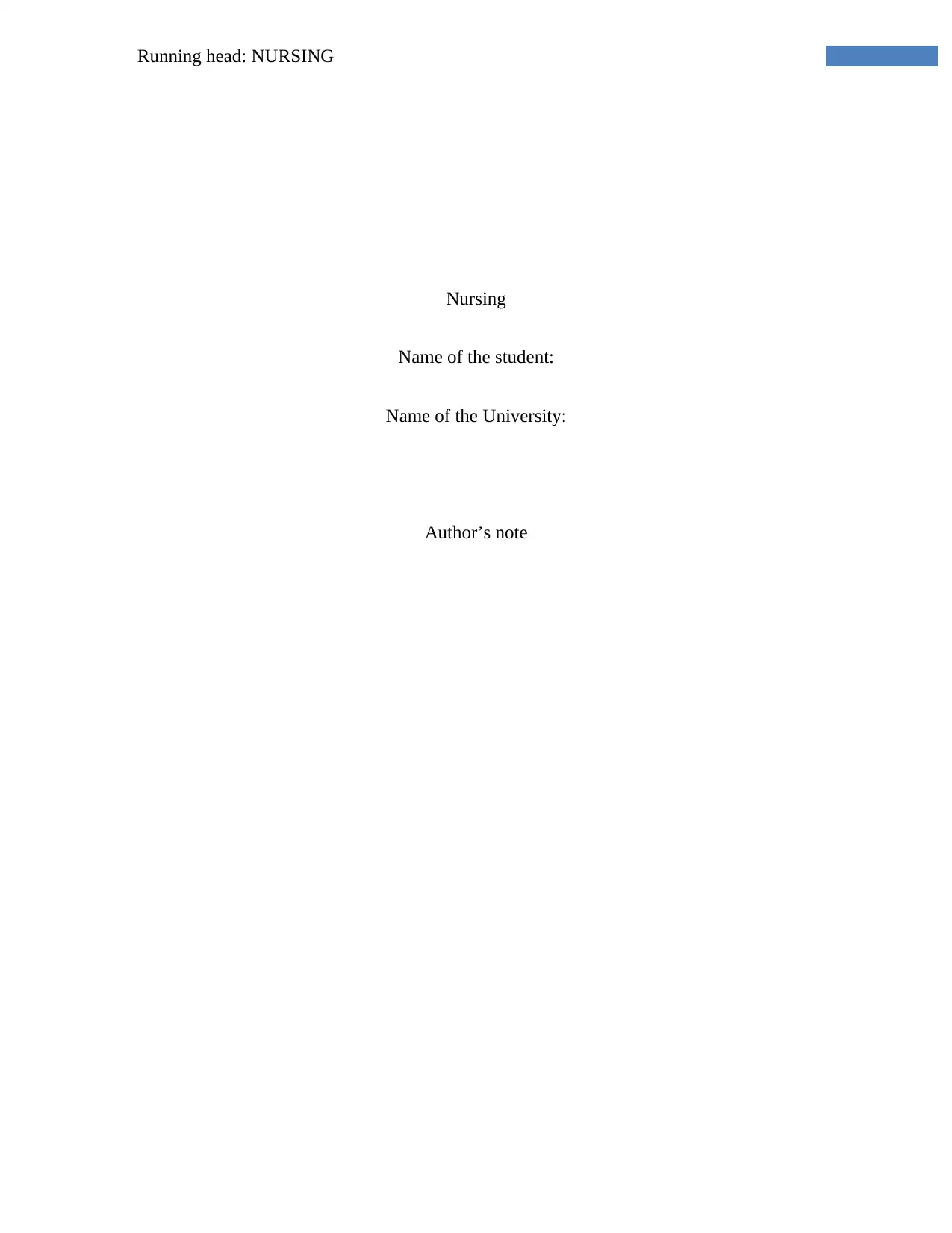
Running head: NURSING
Nursing
Name of the student:
Name of the University:
Author’s note
Nursing
Name of the student:
Name of the University:
Author’s note
Paraphrase This Document
Need a fresh take? Get an instant paraphrase of this document with our AI Paraphraser
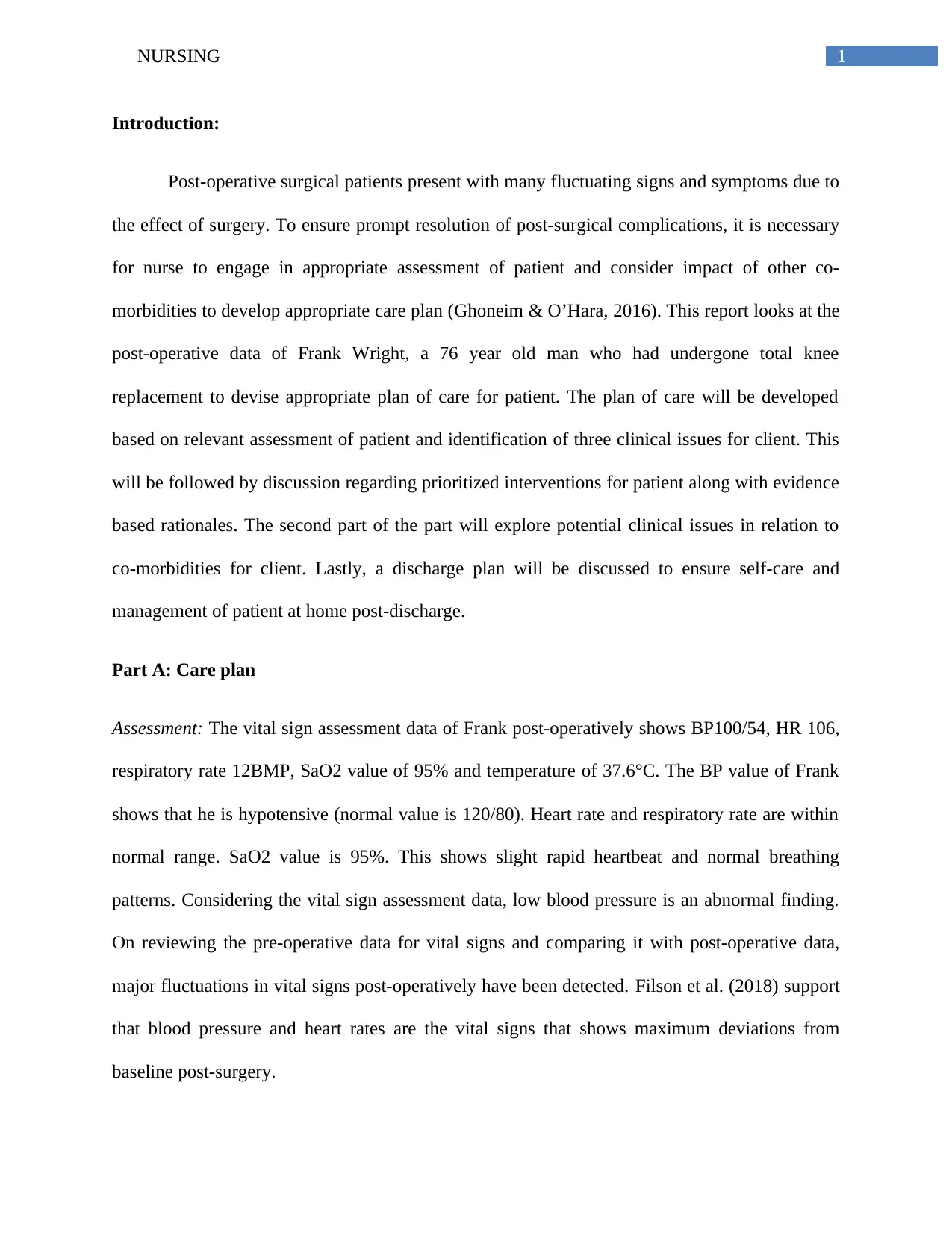
1NURSING
Introduction:
Post-operative surgical patients present with many fluctuating signs and symptoms due to
the effect of surgery. To ensure prompt resolution of post-surgical complications, it is necessary
for nurse to engage in appropriate assessment of patient and consider impact of other co-
morbidities to develop appropriate care plan (Ghoneim & O’Hara, 2016). This report looks at the
post-operative data of Frank Wright, a 76 year old man who had undergone total knee
replacement to devise appropriate plan of care for patient. The plan of care will be developed
based on relevant assessment of patient and identification of three clinical issues for client. This
will be followed by discussion regarding prioritized interventions for patient along with evidence
based rationales. The second part of the part will explore potential clinical issues in relation to
co-morbidities for client. Lastly, a discharge plan will be discussed to ensure self-care and
management of patient at home post-discharge.
Part A: Care plan
Assessment: The vital sign assessment data of Frank post-operatively shows BP100/54, HR 106,
respiratory rate 12BMP, SaO2 value of 95% and temperature of 37.6°C. The BP value of Frank
shows that he is hypotensive (normal value is 120/80). Heart rate and respiratory rate are within
normal range. SaO2 value is 95%. This shows slight rapid heartbeat and normal breathing
patterns. Considering the vital sign assessment data, low blood pressure is an abnormal finding.
On reviewing the pre-operative data for vital signs and comparing it with post-operative data,
major fluctuations in vital signs post-operatively have been detected. Filson et al. (2018) support
that blood pressure and heart rates are the vital signs that shows maximum deviations from
baseline post-surgery.
Introduction:
Post-operative surgical patients present with many fluctuating signs and symptoms due to
the effect of surgery. To ensure prompt resolution of post-surgical complications, it is necessary
for nurse to engage in appropriate assessment of patient and consider impact of other co-
morbidities to develop appropriate care plan (Ghoneim & O’Hara, 2016). This report looks at the
post-operative data of Frank Wright, a 76 year old man who had undergone total knee
replacement to devise appropriate plan of care for patient. The plan of care will be developed
based on relevant assessment of patient and identification of three clinical issues for client. This
will be followed by discussion regarding prioritized interventions for patient along with evidence
based rationales. The second part of the part will explore potential clinical issues in relation to
co-morbidities for client. Lastly, a discharge plan will be discussed to ensure self-care and
management of patient at home post-discharge.
Part A: Care plan
Assessment: The vital sign assessment data of Frank post-operatively shows BP100/54, HR 106,
respiratory rate 12BMP, SaO2 value of 95% and temperature of 37.6°C. The BP value of Frank
shows that he is hypotensive (normal value is 120/80). Heart rate and respiratory rate are within
normal range. SaO2 value is 95%. This shows slight rapid heartbeat and normal breathing
patterns. Considering the vital sign assessment data, low blood pressure is an abnormal finding.
On reviewing the pre-operative data for vital signs and comparing it with post-operative data,
major fluctuations in vital signs post-operatively have been detected. Filson et al. (2018) support
that blood pressure and heart rates are the vital signs that shows maximum deviations from
baseline post-surgery.
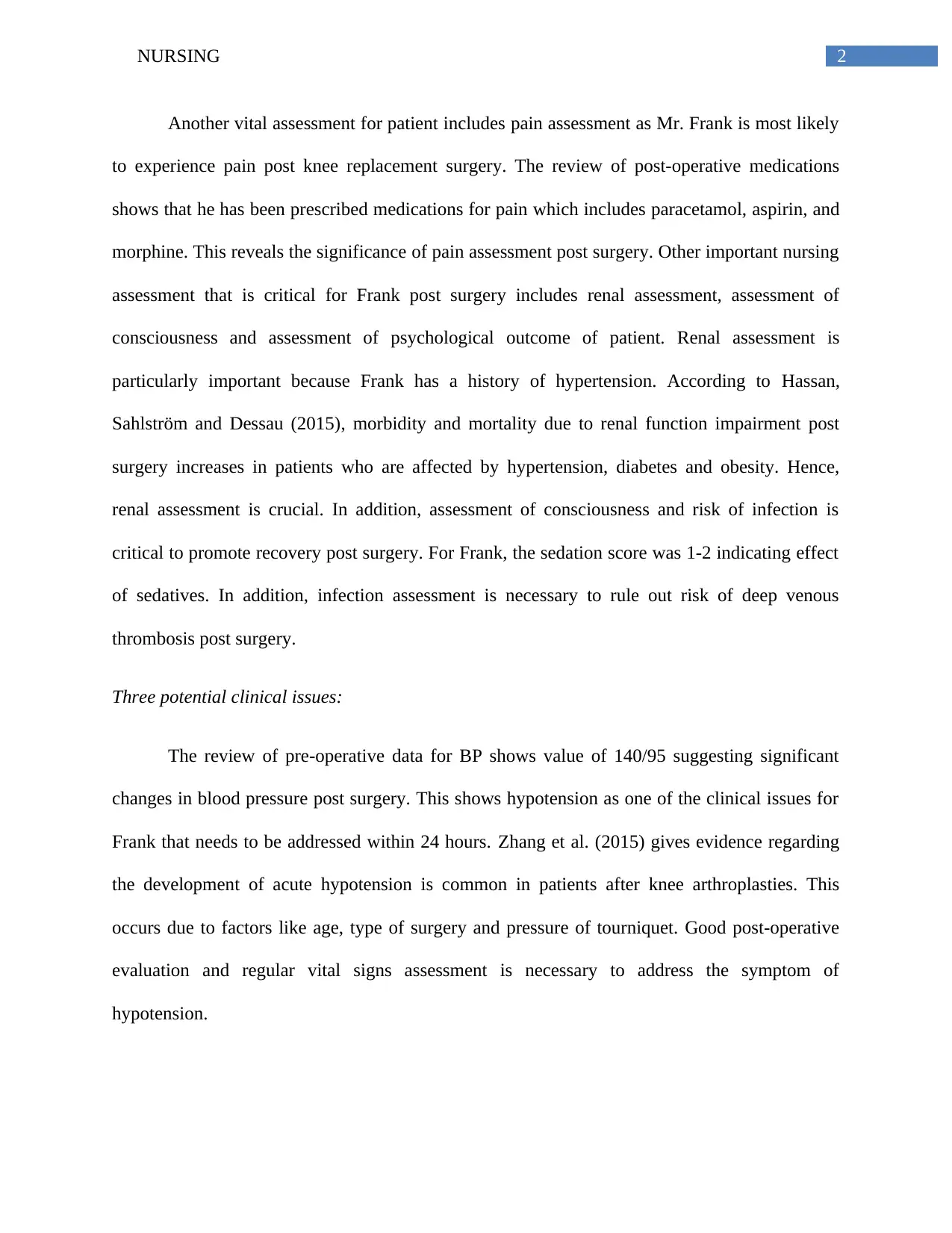
2NURSING
Another vital assessment for patient includes pain assessment as Mr. Frank is most likely
to experience pain post knee replacement surgery. The review of post-operative medications
shows that he has been prescribed medications for pain which includes paracetamol, aspirin, and
morphine. This reveals the significance of pain assessment post surgery. Other important nursing
assessment that is critical for Frank post surgery includes renal assessment, assessment of
consciousness and assessment of psychological outcome of patient. Renal assessment is
particularly important because Frank has a history of hypertension. According to Hassan,
Sahlström and Dessau (2015), morbidity and mortality due to renal function impairment post
surgery increases in patients who are affected by hypertension, diabetes and obesity. Hence,
renal assessment is crucial. In addition, assessment of consciousness and risk of infection is
critical to promote recovery post surgery. For Frank, the sedation score was 1-2 indicating effect
of sedatives. In addition, infection assessment is necessary to rule out risk of deep venous
thrombosis post surgery.
Three potential clinical issues:
The review of pre-operative data for BP shows value of 140/95 suggesting significant
changes in blood pressure post surgery. This shows hypotension as one of the clinical issues for
Frank that needs to be addressed within 24 hours. Zhang et al. (2015) gives evidence regarding
the development of acute hypotension is common in patients after knee arthroplasties. This
occurs due to factors like age, type of surgery and pressure of tourniquet. Good post-operative
evaluation and regular vital signs assessment is necessary to address the symptom of
hypotension.
Another vital assessment for patient includes pain assessment as Mr. Frank is most likely
to experience pain post knee replacement surgery. The review of post-operative medications
shows that he has been prescribed medications for pain which includes paracetamol, aspirin, and
morphine. This reveals the significance of pain assessment post surgery. Other important nursing
assessment that is critical for Frank post surgery includes renal assessment, assessment of
consciousness and assessment of psychological outcome of patient. Renal assessment is
particularly important because Frank has a history of hypertension. According to Hassan,
Sahlström and Dessau (2015), morbidity and mortality due to renal function impairment post
surgery increases in patients who are affected by hypertension, diabetes and obesity. Hence,
renal assessment is crucial. In addition, assessment of consciousness and risk of infection is
critical to promote recovery post surgery. For Frank, the sedation score was 1-2 indicating effect
of sedatives. In addition, infection assessment is necessary to rule out risk of deep venous
thrombosis post surgery.
Three potential clinical issues:
The review of pre-operative data for BP shows value of 140/95 suggesting significant
changes in blood pressure post surgery. This shows hypotension as one of the clinical issues for
Frank that needs to be addressed within 24 hours. Zhang et al. (2015) gives evidence regarding
the development of acute hypotension is common in patients after knee arthroplasties. This
occurs due to factors like age, type of surgery and pressure of tourniquet. Good post-operative
evaluation and regular vital signs assessment is necessary to address the symptom of
hypotension.
⊘ This is a preview!⊘
Do you want full access?
Subscribe today to unlock all pages.

Trusted by 1+ million students worldwide
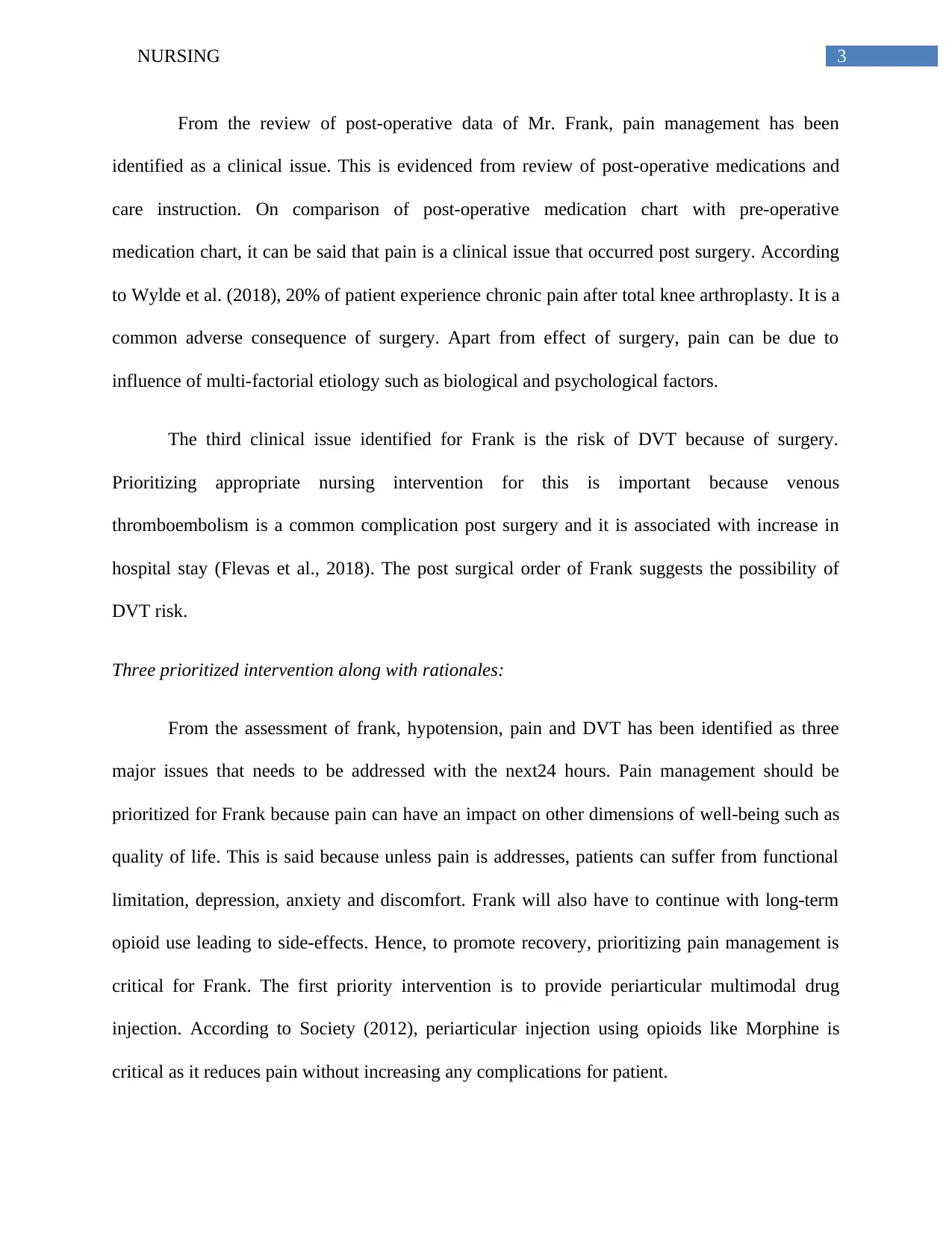
3NURSING
From the review of post-operative data of Mr. Frank, pain management has been
identified as a clinical issue. This is evidenced from review of post-operative medications and
care instruction. On comparison of post-operative medication chart with pre-operative
medication chart, it can be said that pain is a clinical issue that occurred post surgery. According
to Wylde et al. (2018), 20% of patient experience chronic pain after total knee arthroplasty. It is a
common adverse consequence of surgery. Apart from effect of surgery, pain can be due to
influence of multi-factorial etiology such as biological and psychological factors.
The third clinical issue identified for Frank is the risk of DVT because of surgery.
Prioritizing appropriate nursing intervention for this is important because venous
thromboembolism is a common complication post surgery and it is associated with increase in
hospital stay (Flevas et al., 2018). The post surgical order of Frank suggests the possibility of
DVT risk.
Three prioritized intervention along with rationales:
From the assessment of frank, hypotension, pain and DVT has been identified as three
major issues that needs to be addressed with the next24 hours. Pain management should be
prioritized for Frank because pain can have an impact on other dimensions of well-being such as
quality of life. This is said because unless pain is addresses, patients can suffer from functional
limitation, depression, anxiety and discomfort. Frank will also have to continue with long-term
opioid use leading to side-effects. Hence, to promote recovery, prioritizing pain management is
critical for Frank. The first priority intervention is to provide periarticular multimodal drug
injection. According to Society (2012), periarticular injection using opioids like Morphine is
critical as it reduces pain without increasing any complications for patient.
From the review of post-operative data of Mr. Frank, pain management has been
identified as a clinical issue. This is evidenced from review of post-operative medications and
care instruction. On comparison of post-operative medication chart with pre-operative
medication chart, it can be said that pain is a clinical issue that occurred post surgery. According
to Wylde et al. (2018), 20% of patient experience chronic pain after total knee arthroplasty. It is a
common adverse consequence of surgery. Apart from effect of surgery, pain can be due to
influence of multi-factorial etiology such as biological and psychological factors.
The third clinical issue identified for Frank is the risk of DVT because of surgery.
Prioritizing appropriate nursing intervention for this is important because venous
thromboembolism is a common complication post surgery and it is associated with increase in
hospital stay (Flevas et al., 2018). The post surgical order of Frank suggests the possibility of
DVT risk.
Three prioritized intervention along with rationales:
From the assessment of frank, hypotension, pain and DVT has been identified as three
major issues that needs to be addressed with the next24 hours. Pain management should be
prioritized for Frank because pain can have an impact on other dimensions of well-being such as
quality of life. This is said because unless pain is addresses, patients can suffer from functional
limitation, depression, anxiety and discomfort. Frank will also have to continue with long-term
opioid use leading to side-effects. Hence, to promote recovery, prioritizing pain management is
critical for Frank. The first priority intervention is to provide periarticular multimodal drug
injection. According to Society (2012), periarticular injection using opioids like Morphine is
critical as it reduces pain without increasing any complications for patient.
Paraphrase This Document
Need a fresh take? Get an instant paraphrase of this document with our AI Paraphraser
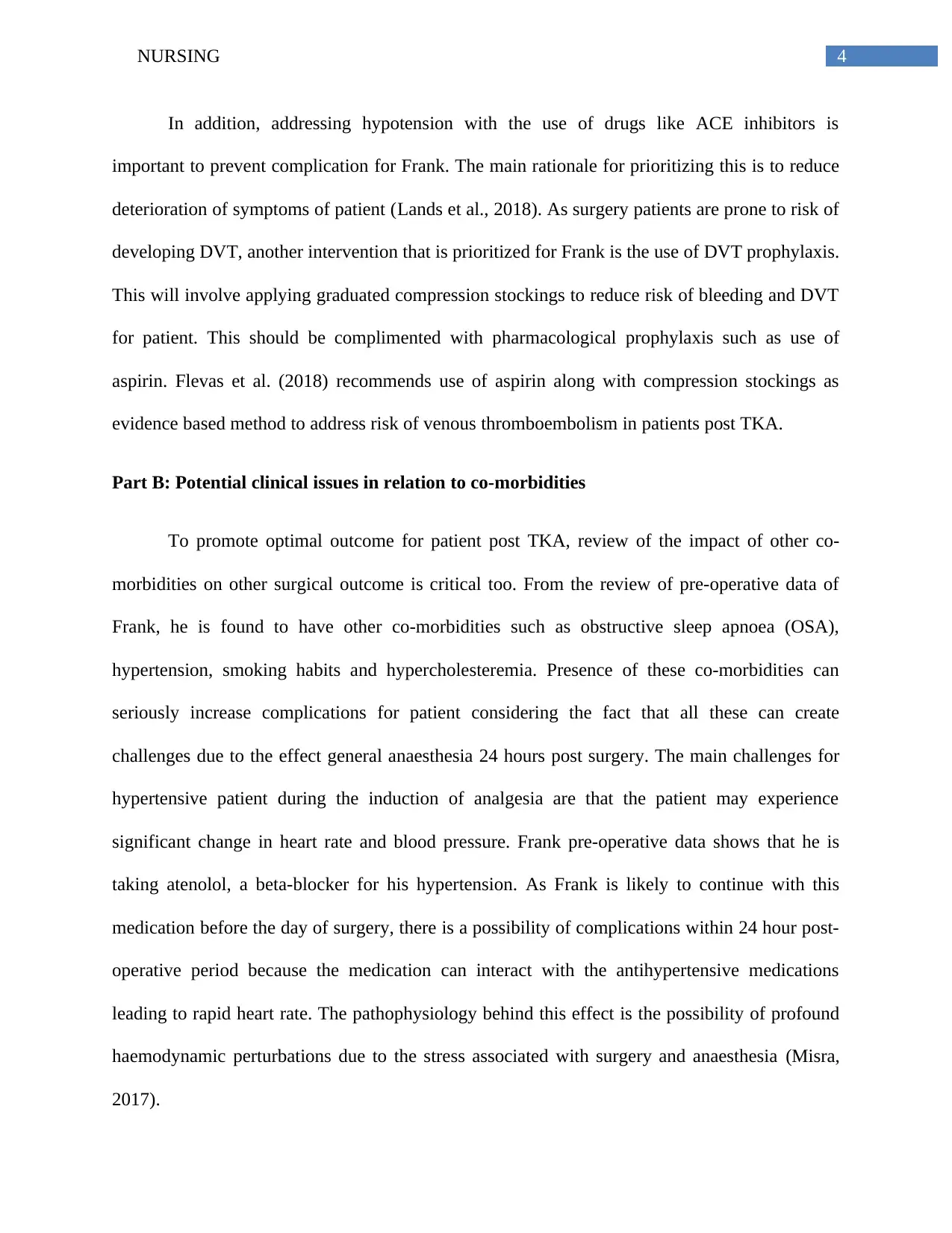
4NURSING
In addition, addressing hypotension with the use of drugs like ACE inhibitors is
important to prevent complication for Frank. The main rationale for prioritizing this is to reduce
deterioration of symptoms of patient (Lands et al., 2018). As surgery patients are prone to risk of
developing DVT, another intervention that is prioritized for Frank is the use of DVT prophylaxis.
This will involve applying graduated compression stockings to reduce risk of bleeding and DVT
for patient. This should be complimented with pharmacological prophylaxis such as use of
aspirin. Flevas et al. (2018) recommends use of aspirin along with compression stockings as
evidence based method to address risk of venous thromboembolism in patients post TKA.
Part B: Potential clinical issues in relation to co-morbidities
To promote optimal outcome for patient post TKA, review of the impact of other co-
morbidities on other surgical outcome is critical too. From the review of pre-operative data of
Frank, he is found to have other co-morbidities such as obstructive sleep apnoea (OSA),
hypertension, smoking habits and hypercholesteremia. Presence of these co-morbidities can
seriously increase complications for patient considering the fact that all these can create
challenges due to the effect general anaesthesia 24 hours post surgery. The main challenges for
hypertensive patient during the induction of analgesia are that the patient may experience
significant change in heart rate and blood pressure. Frank pre-operative data shows that he is
taking atenolol, a beta-blocker for his hypertension. As Frank is likely to continue with this
medication before the day of surgery, there is a possibility of complications within 24 hour post-
operative period because the medication can interact with the antihypertensive medications
leading to rapid heart rate. The pathophysiology behind this effect is the possibility of profound
haemodynamic perturbations due to the stress associated with surgery and anaesthesia (Misra,
2017).
In addition, addressing hypotension with the use of drugs like ACE inhibitors is
important to prevent complication for Frank. The main rationale for prioritizing this is to reduce
deterioration of symptoms of patient (Lands et al., 2018). As surgery patients are prone to risk of
developing DVT, another intervention that is prioritized for Frank is the use of DVT prophylaxis.
This will involve applying graduated compression stockings to reduce risk of bleeding and DVT
for patient. This should be complimented with pharmacological prophylaxis such as use of
aspirin. Flevas et al. (2018) recommends use of aspirin along with compression stockings as
evidence based method to address risk of venous thromboembolism in patients post TKA.
Part B: Potential clinical issues in relation to co-morbidities
To promote optimal outcome for patient post TKA, review of the impact of other co-
morbidities on other surgical outcome is critical too. From the review of pre-operative data of
Frank, he is found to have other co-morbidities such as obstructive sleep apnoea (OSA),
hypertension, smoking habits and hypercholesteremia. Presence of these co-morbidities can
seriously increase complications for patient considering the fact that all these can create
challenges due to the effect general anaesthesia 24 hours post surgery. The main challenges for
hypertensive patient during the induction of analgesia are that the patient may experience
significant change in heart rate and blood pressure. Frank pre-operative data shows that he is
taking atenolol, a beta-blocker for his hypertension. As Frank is likely to continue with this
medication before the day of surgery, there is a possibility of complications within 24 hour post-
operative period because the medication can interact with the antihypertensive medications
leading to rapid heart rate. The pathophysiology behind this effect is the possibility of profound
haemodynamic perturbations due to the stress associated with surgery and anaesthesia (Misra,
2017).
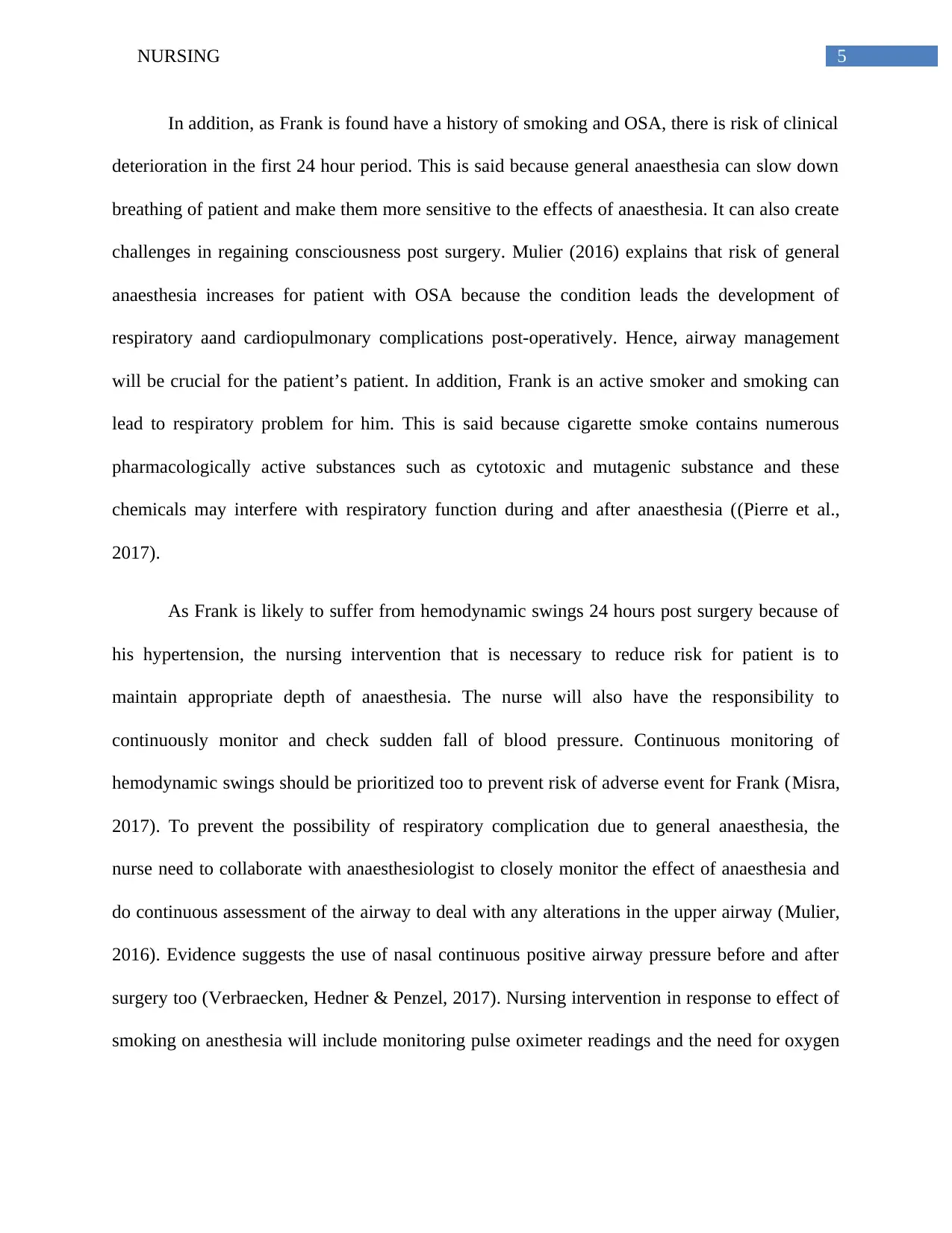
5NURSING
In addition, as Frank is found have a history of smoking and OSA, there is risk of clinical
deterioration in the first 24 hour period. This is said because general anaesthesia can slow down
breathing of patient and make them more sensitive to the effects of anaesthesia. It can also create
challenges in regaining consciousness post surgery. Mulier (2016) explains that risk of general
anaesthesia increases for patient with OSA because the condition leads the development of
respiratory aand cardiopulmonary complications post-operatively. Hence, airway management
will be crucial for the patient’s patient. In addition, Frank is an active smoker and smoking can
lead to respiratory problem for him. This is said because cigarette smoke contains numerous
pharmacologically active substances such as cytotoxic and mutagenic substance and these
chemicals may interfere with respiratory function during and after anaesthesia ((Pierre et al.,
2017).
As Frank is likely to suffer from hemodynamic swings 24 hours post surgery because of
his hypertension, the nursing intervention that is necessary to reduce risk for patient is to
maintain appropriate depth of anaesthesia. The nurse will also have the responsibility to
continuously monitor and check sudden fall of blood pressure. Continuous monitoring of
hemodynamic swings should be prioritized too to prevent risk of adverse event for Frank (Misra,
2017). To prevent the possibility of respiratory complication due to general anaesthesia, the
nurse need to collaborate with anaesthesiologist to closely monitor the effect of anaesthesia and
do continuous assessment of the airway to deal with any alterations in the upper airway (Mulier,
2016). Evidence suggests the use of nasal continuous positive airway pressure before and after
surgery too (Verbraecken, Hedner & Penzel, 2017). Nursing intervention in response to effect of
smoking on anesthesia will include monitoring pulse oximeter readings and the need for oxygen
In addition, as Frank is found have a history of smoking and OSA, there is risk of clinical
deterioration in the first 24 hour period. This is said because general anaesthesia can slow down
breathing of patient and make them more sensitive to the effects of anaesthesia. It can also create
challenges in regaining consciousness post surgery. Mulier (2016) explains that risk of general
anaesthesia increases for patient with OSA because the condition leads the development of
respiratory aand cardiopulmonary complications post-operatively. Hence, airway management
will be crucial for the patient’s patient. In addition, Frank is an active smoker and smoking can
lead to respiratory problem for him. This is said because cigarette smoke contains numerous
pharmacologically active substances such as cytotoxic and mutagenic substance and these
chemicals may interfere with respiratory function during and after anaesthesia ((Pierre et al.,
2017).
As Frank is likely to suffer from hemodynamic swings 24 hours post surgery because of
his hypertension, the nursing intervention that is necessary to reduce risk for patient is to
maintain appropriate depth of anaesthesia. The nurse will also have the responsibility to
continuously monitor and check sudden fall of blood pressure. Continuous monitoring of
hemodynamic swings should be prioritized too to prevent risk of adverse event for Frank (Misra,
2017). To prevent the possibility of respiratory complication due to general anaesthesia, the
nurse need to collaborate with anaesthesiologist to closely monitor the effect of anaesthesia and
do continuous assessment of the airway to deal with any alterations in the upper airway (Mulier,
2016). Evidence suggests the use of nasal continuous positive airway pressure before and after
surgery too (Verbraecken, Hedner & Penzel, 2017). Nursing intervention in response to effect of
smoking on anesthesia will include monitoring pulse oximeter readings and the need for oxygen
⊘ This is a preview!⊘
Do you want full access?
Subscribe today to unlock all pages.

Trusted by 1+ million students worldwide
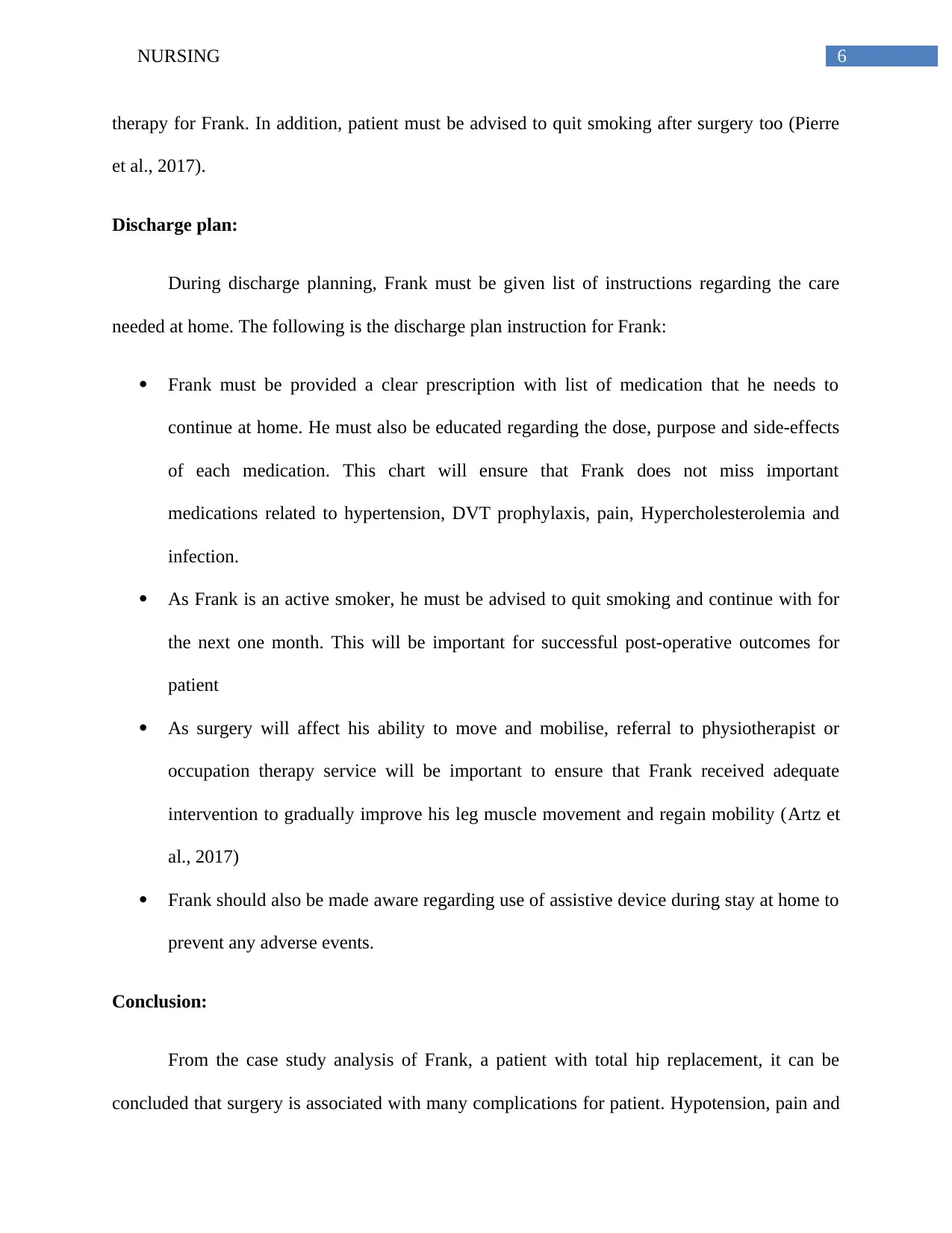
6NURSING
therapy for Frank. In addition, patient must be advised to quit smoking after surgery too (Pierre
et al., 2017).
Discharge plan:
During discharge planning, Frank must be given list of instructions regarding the care
needed at home. The following is the discharge plan instruction for Frank:
Frank must be provided a clear prescription with list of medication that he needs to
continue at home. He must also be educated regarding the dose, purpose and side-effects
of each medication. This chart will ensure that Frank does not miss important
medications related to hypertension, DVT prophylaxis, pain, Hypercholesterolemia and
infection.
As Frank is an active smoker, he must be advised to quit smoking and continue with for
the next one month. This will be important for successful post-operative outcomes for
patient
As surgery will affect his ability to move and mobilise, referral to physiotherapist or
occupation therapy service will be important to ensure that Frank received adequate
intervention to gradually improve his leg muscle movement and regain mobility (Artz et
al., 2017)
Frank should also be made aware regarding use of assistive device during stay at home to
prevent any adverse events.
Conclusion:
From the case study analysis of Frank, a patient with total hip replacement, it can be
concluded that surgery is associated with many complications for patient. Hypotension, pain and
therapy for Frank. In addition, patient must be advised to quit smoking after surgery too (Pierre
et al., 2017).
Discharge plan:
During discharge planning, Frank must be given list of instructions regarding the care
needed at home. The following is the discharge plan instruction for Frank:
Frank must be provided a clear prescription with list of medication that he needs to
continue at home. He must also be educated regarding the dose, purpose and side-effects
of each medication. This chart will ensure that Frank does not miss important
medications related to hypertension, DVT prophylaxis, pain, Hypercholesterolemia and
infection.
As Frank is an active smoker, he must be advised to quit smoking and continue with for
the next one month. This will be important for successful post-operative outcomes for
patient
As surgery will affect his ability to move and mobilise, referral to physiotherapist or
occupation therapy service will be important to ensure that Frank received adequate
intervention to gradually improve his leg muscle movement and regain mobility (Artz et
al., 2017)
Frank should also be made aware regarding use of assistive device during stay at home to
prevent any adverse events.
Conclusion:
From the case study analysis of Frank, a patient with total hip replacement, it can be
concluded that surgery is associated with many complications for patient. Hypotension, pain and
Paraphrase This Document
Need a fresh take? Get an instant paraphrase of this document with our AI Paraphraser
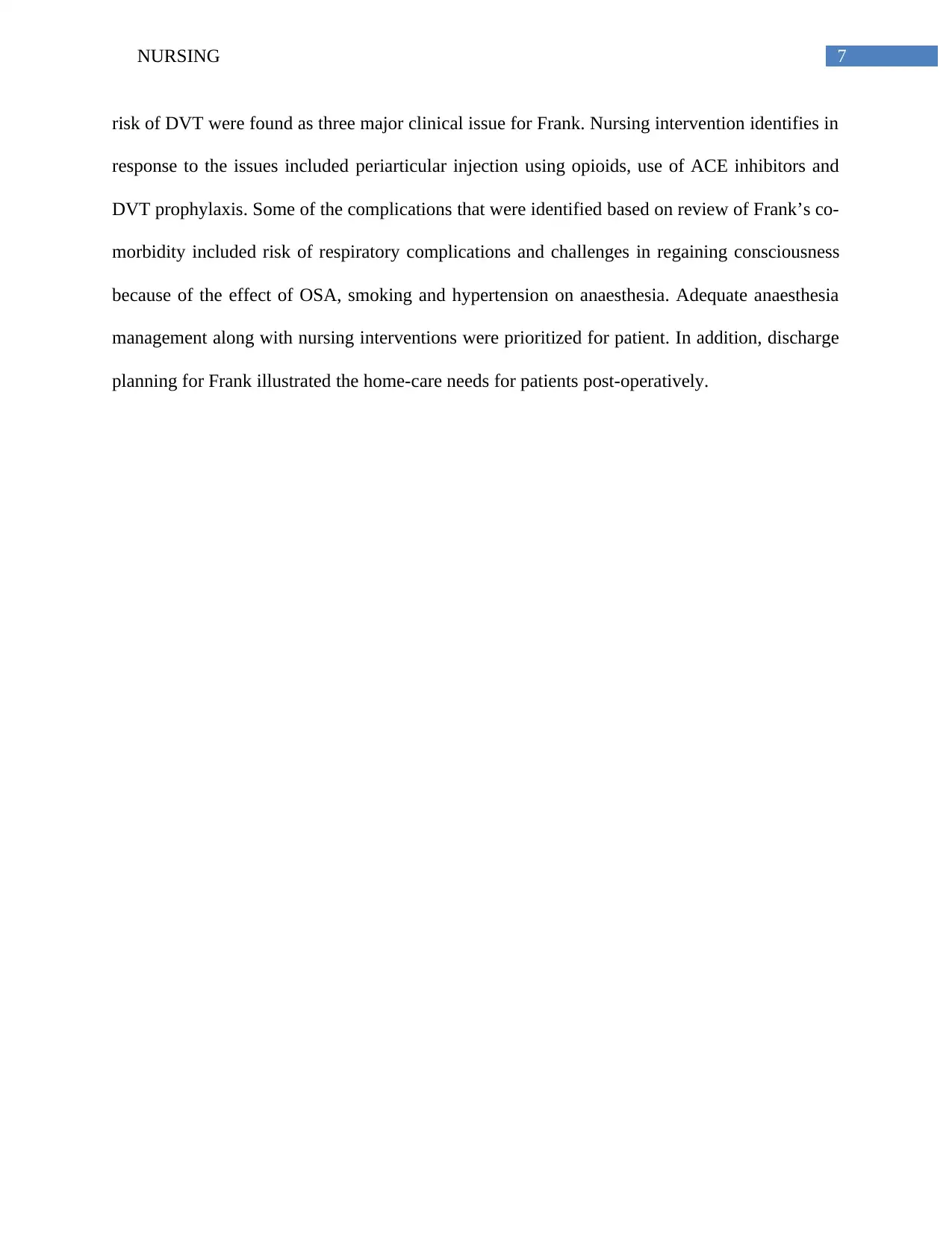
7NURSING
risk of DVT were found as three major clinical issue for Frank. Nursing intervention identifies in
response to the issues included periarticular injection using opioids, use of ACE inhibitors and
DVT prophylaxis. Some of the complications that were identified based on review of Frank’s co-
morbidity included risk of respiratory complications and challenges in regaining consciousness
because of the effect of OSA, smoking and hypertension on anaesthesia. Adequate anaesthesia
management along with nursing interventions were prioritized for patient. In addition, discharge
planning for Frank illustrated the home-care needs for patients post-operatively.
risk of DVT were found as three major clinical issue for Frank. Nursing intervention identifies in
response to the issues included periarticular injection using opioids, use of ACE inhibitors and
DVT prophylaxis. Some of the complications that were identified based on review of Frank’s co-
morbidity included risk of respiratory complications and challenges in regaining consciousness
because of the effect of OSA, smoking and hypertension on anaesthesia. Adequate anaesthesia
management along with nursing interventions were prioritized for patient. In addition, discharge
planning for Frank illustrated the home-care needs for patients post-operatively.
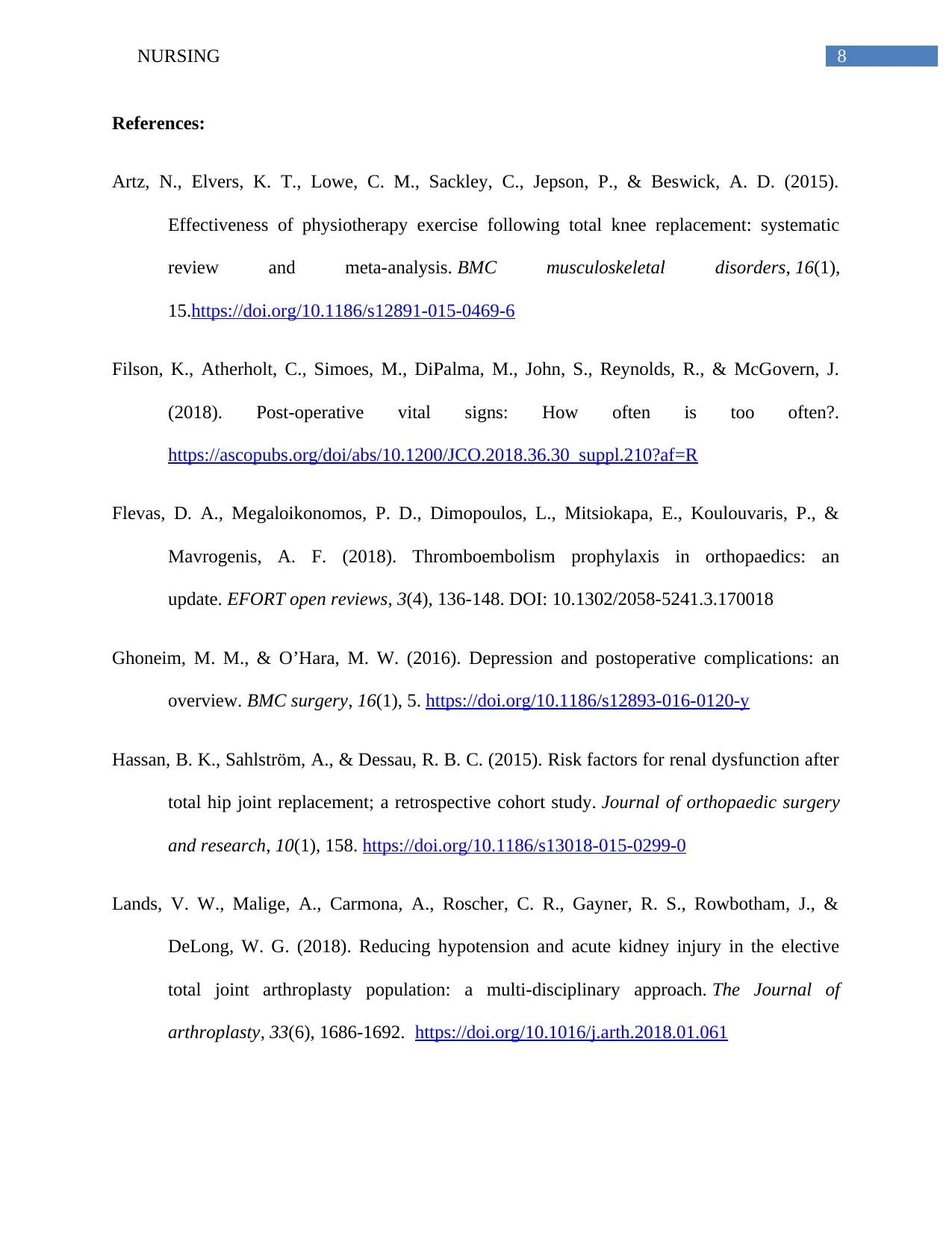
8NURSING
References:
Artz, N., Elvers, K. T., Lowe, C. M., Sackley, C., Jepson, P., & Beswick, A. D. (2015).
Effectiveness of physiotherapy exercise following total knee replacement: systematic
review and meta-analysis. BMC musculoskeletal disorders, 16(1),
15.https://doi.org/10.1186/s12891-015-0469-6
Filson, K., Atherholt, C., Simoes, M., DiPalma, M., John, S., Reynolds, R., & McGovern, J.
(2018). Post-operative vital signs: How often is too often?.
https://ascopubs.org/doi/abs/10.1200/JCO.2018.36.30_suppl.210?af=R
Flevas, D. A., Megaloikonomos, P. D., Dimopoulos, L., Mitsiokapa, E., Koulouvaris, P., &
Mavrogenis, A. F. (2018). Thromboembolism prophylaxis in orthopaedics: an
update. EFORT open reviews, 3(4), 136-148. DOI: 10.1302/2058-5241.3.170018
Ghoneim, M. M., & O’Hara, M. W. (2016). Depression and postoperative complications: an
overview. BMC surgery, 16(1), 5. https://doi.org/10.1186/s12893-016-0120-y
Hassan, B. K., Sahlström, A., & Dessau, R. B. C. (2015). Risk factors for renal dysfunction after
total hip joint replacement; a retrospective cohort study. Journal of orthopaedic surgery
and research, 10(1), 158. https://doi.org/10.1186/s13018-015-0299-0
Lands, V. W., Malige, A., Carmona, A., Roscher, C. R., Gayner, R. S., Rowbotham, J., &
DeLong, W. G. (2018). Reducing hypotension and acute kidney injury in the elective
total joint arthroplasty population: a multi-disciplinary approach. The Journal of
arthroplasty, 33(6), 1686-1692. https://doi.org/10.1016/j.arth.2018.01.061
References:
Artz, N., Elvers, K. T., Lowe, C. M., Sackley, C., Jepson, P., & Beswick, A. D. (2015).
Effectiveness of physiotherapy exercise following total knee replacement: systematic
review and meta-analysis. BMC musculoskeletal disorders, 16(1),
15.https://doi.org/10.1186/s12891-015-0469-6
Filson, K., Atherholt, C., Simoes, M., DiPalma, M., John, S., Reynolds, R., & McGovern, J.
(2018). Post-operative vital signs: How often is too often?.
https://ascopubs.org/doi/abs/10.1200/JCO.2018.36.30_suppl.210?af=R
Flevas, D. A., Megaloikonomos, P. D., Dimopoulos, L., Mitsiokapa, E., Koulouvaris, P., &
Mavrogenis, A. F. (2018). Thromboembolism prophylaxis in orthopaedics: an
update. EFORT open reviews, 3(4), 136-148. DOI: 10.1302/2058-5241.3.170018
Ghoneim, M. M., & O’Hara, M. W. (2016). Depression and postoperative complications: an
overview. BMC surgery, 16(1), 5. https://doi.org/10.1186/s12893-016-0120-y
Hassan, B. K., Sahlström, A., & Dessau, R. B. C. (2015). Risk factors for renal dysfunction after
total hip joint replacement; a retrospective cohort study. Journal of orthopaedic surgery
and research, 10(1), 158. https://doi.org/10.1186/s13018-015-0299-0
Lands, V. W., Malige, A., Carmona, A., Roscher, C. R., Gayner, R. S., Rowbotham, J., &
DeLong, W. G. (2018). Reducing hypotension and acute kidney injury in the elective
total joint arthroplasty population: a multi-disciplinary approach. The Journal of
arthroplasty, 33(6), 1686-1692. https://doi.org/10.1016/j.arth.2018.01.061
⊘ This is a preview!⊘
Do you want full access?
Subscribe today to unlock all pages.

Trusted by 1+ million students worldwide
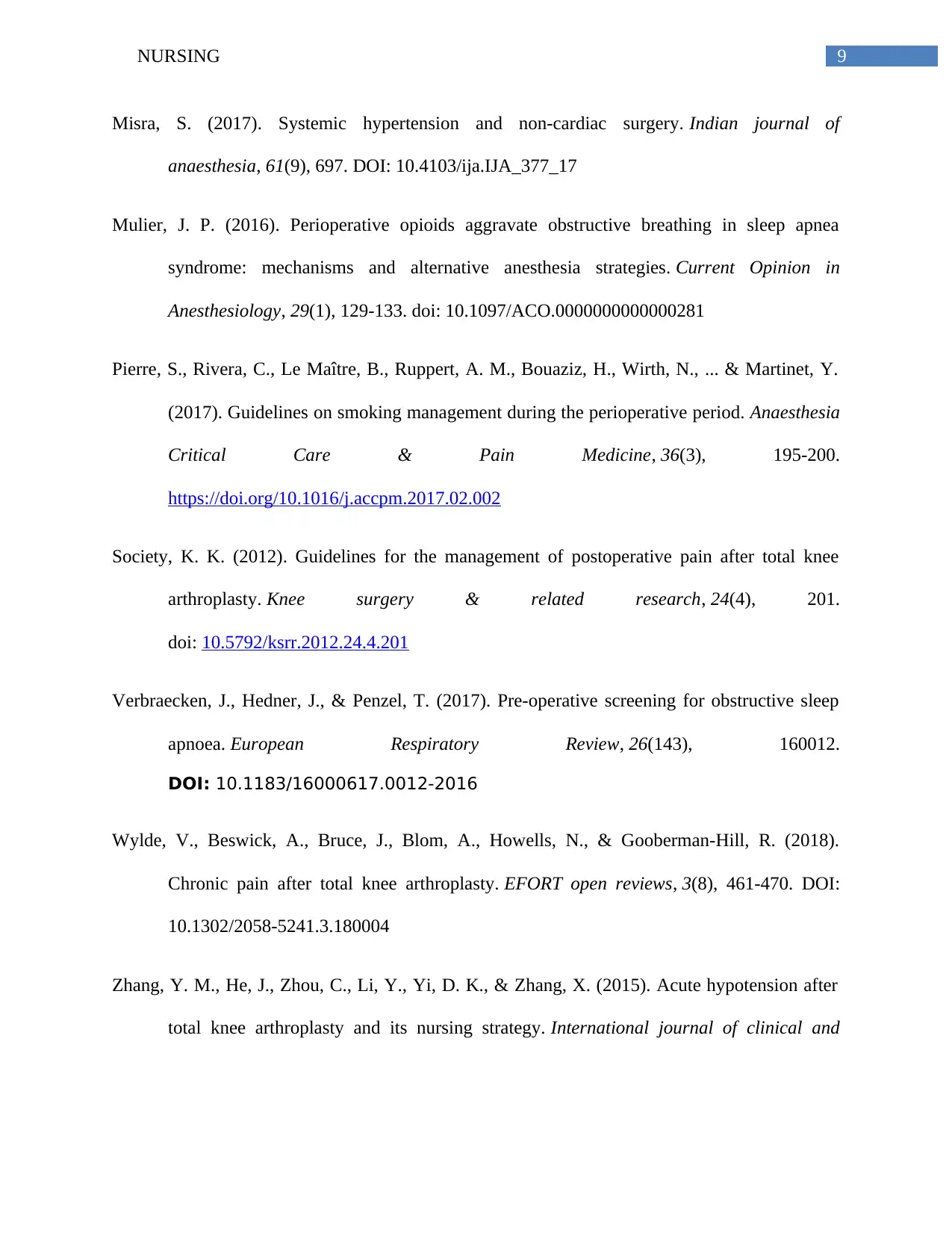
9NURSING
Misra, S. (2017). Systemic hypertension and non-cardiac surgery. Indian journal of
anaesthesia, 61(9), 697. DOI: 10.4103/ija.IJA_377_17
Mulier, J. P. (2016). Perioperative opioids aggravate obstructive breathing in sleep apnea
syndrome: mechanisms and alternative anesthesia strategies. Current Opinion in
Anesthesiology, 29(1), 129-133. doi: 10.1097/ACO.0000000000000281
Pierre, S., Rivera, C., Le Maître, B., Ruppert, A. M., Bouaziz, H., Wirth, N., ... & Martinet, Y.
(2017). Guidelines on smoking management during the perioperative period. Anaesthesia
Critical Care & Pain Medicine, 36(3), 195-200.
https://doi.org/10.1016/j.accpm.2017.02.002
Society, K. K. (2012). Guidelines for the management of postoperative pain after total knee
arthroplasty. Knee surgery & related research, 24(4), 201.
doi: 10.5792/ksrr.2012.24.4.201
Verbraecken, J., Hedner, J., & Penzel, T. (2017). Pre-operative screening for obstructive sleep
apnoea. European Respiratory Review, 26(143), 160012.
DOI: 10.1183/16000617.0012-2016
Wylde, V., Beswick, A., Bruce, J., Blom, A., Howells, N., & Gooberman-Hill, R. (2018).
Chronic pain after total knee arthroplasty. EFORT open reviews, 3(8), 461-470. DOI:
10.1302/2058-5241.3.180004
Zhang, Y. M., He, J., Zhou, C., Li, Y., Yi, D. K., & Zhang, X. (2015). Acute hypotension after
total knee arthroplasty and its nursing strategy. International journal of clinical and
Misra, S. (2017). Systemic hypertension and non-cardiac surgery. Indian journal of
anaesthesia, 61(9), 697. DOI: 10.4103/ija.IJA_377_17
Mulier, J. P. (2016). Perioperative opioids aggravate obstructive breathing in sleep apnea
syndrome: mechanisms and alternative anesthesia strategies. Current Opinion in
Anesthesiology, 29(1), 129-133. doi: 10.1097/ACO.0000000000000281
Pierre, S., Rivera, C., Le Maître, B., Ruppert, A. M., Bouaziz, H., Wirth, N., ... & Martinet, Y.
(2017). Guidelines on smoking management during the perioperative period. Anaesthesia
Critical Care & Pain Medicine, 36(3), 195-200.
https://doi.org/10.1016/j.accpm.2017.02.002
Society, K. K. (2012). Guidelines for the management of postoperative pain after total knee
arthroplasty. Knee surgery & related research, 24(4), 201.
doi: 10.5792/ksrr.2012.24.4.201
Verbraecken, J., Hedner, J., & Penzel, T. (2017). Pre-operative screening for obstructive sleep
apnoea. European Respiratory Review, 26(143), 160012.
DOI: 10.1183/16000617.0012-2016
Wylde, V., Beswick, A., Bruce, J., Blom, A., Howells, N., & Gooberman-Hill, R. (2018).
Chronic pain after total knee arthroplasty. EFORT open reviews, 3(8), 461-470. DOI:
10.1302/2058-5241.3.180004
Zhang, Y. M., He, J., Zhou, C., Li, Y., Yi, D. K., & Zhang, X. (2015). Acute hypotension after
total knee arthroplasty and its nursing strategy. International journal of clinical and
Paraphrase This Document
Need a fresh take? Get an instant paraphrase of this document with our AI Paraphraser

10NURSING
experimental medicine, 8(8), 13946.
https://www.ncbi.nlm.nih.gov/pmc/articles/PMC4613036/pdf/ijcem0008-13946.pdf
experimental medicine, 8(8), 13946.
https://www.ncbi.nlm.nih.gov/pmc/articles/PMC4613036/pdf/ijcem0008-13946.pdf
1 out of 11
Related Documents
Your All-in-One AI-Powered Toolkit for Academic Success.
+13062052269
info@desklib.com
Available 24*7 on WhatsApp / Email
![[object Object]](/_next/static/media/star-bottom.7253800d.svg)
Unlock your academic potential
Copyright © 2020–2025 A2Z Services. All Rights Reserved. Developed and managed by ZUCOL.


